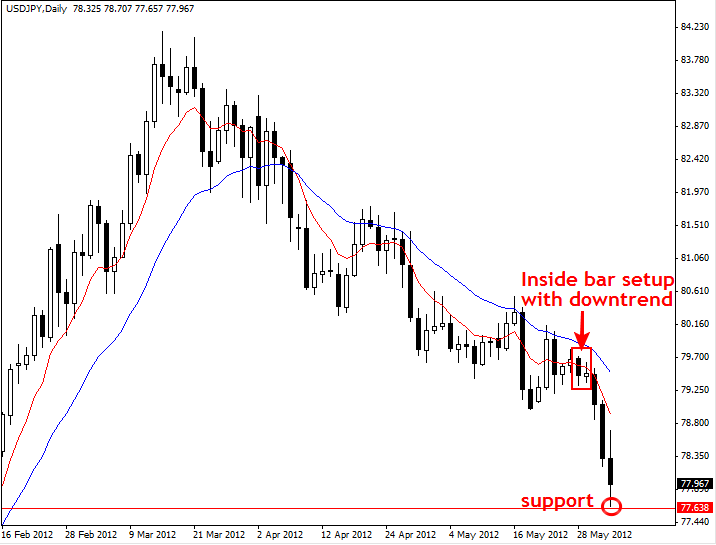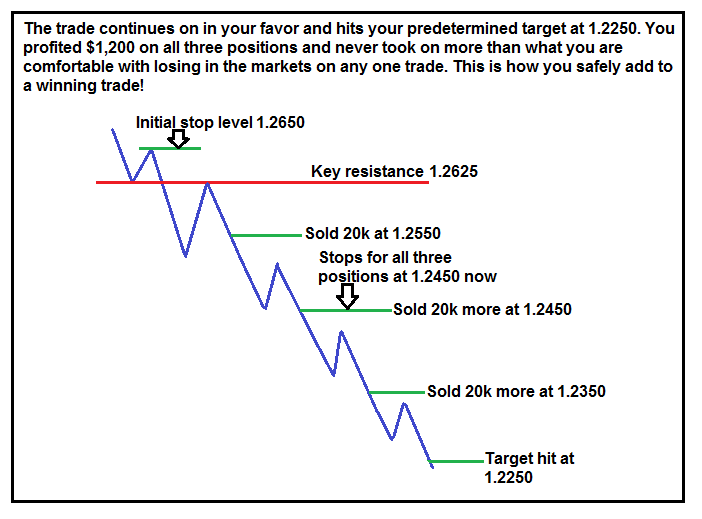Pyramiding A Money Management Strategy To Increase Profits » Learn To Trade
Post on: 26 Май, 2015 No Comment

Pyramiding A Money Management Strategy To Increase Profits
In todays lesson I am going to teach you guys how to trade with the markets money. Thats right, I am going to show you how to scale in or pyramid into a winning trade, without taking on more risk. This essentially means you will add to an open winning position without taking on more risk and possibly even creating a risk-free trade, all while dramatically increasing your potential profit. Its not too good to be true, but there are certain times when scaling into a trade works better than others, which we will discuss in todays lesson. (Note: scaling in is the same thing as adding to a position or pyramiding in)
You’ve probably heard the saying “Cut your losers short and let your winners run”, but how do you actually do that. Today’s Forex trading training lesson is going to teach you how to properly scale into an open trade that’s in profit, so that you get the most out of your winning trades. You probably know that many of the major Forex pairs have been trending quite nicely recently, if not, then check out my recent Forex market update to learn more. With all these strong trends that are taking place recently, I thought it would be good a idea to chuck out an article to you guys about how best to maximize your winning trades. So, let’s get started….
Note: When you finish reading todays lesson, please leave me a comment and let me know if you found this information helpful!
How to safely scale in or pyramid into a winning trade
Note that I have “safely” in italics above, that’s because there are basically two ways that you can add to a winning open position:
1) The stupid way – Scaling into your position but not trailing your stop up or down to reduce risk on the previous position(s), thereby voluntarily taking on more risk (something you should NEVER do).
2) The smart way – Scaling into your position at predetermined levels and trailing your stop up or down each time you add a new position so that you never risk more than you are comfortable with losing, or more than what you have predetermined is a good 1R value for you (1R = the amount you risk per trade).
I am going to teach you guys how to safely pyramid into your trades today, but before we get started I need to stress one thing:
WARNING: Just because you can scale into an open position that is in profit doesn’t mean you SHOULD. There are certain times when the strategies you are about to learn will work well and certain times when they won’t. In general, you can try to scale into a winning position when a market is in a strong trend or during strong intra-day moves. You should not try scaling in when the market is range-bound or trending in a choppy manner with a lot of back and filling.
Now, because you are adding a new position each time your current trade moves a certain distance in your favor, your breakeven point on the whole position moves closer to the market price. This means the market doesn’t have to move as far to put you into negative territory. Now, this won’t be a problem if you have trailed your stop loss on the previous position(s) so that you maintain your overall 1R risk, but where traders get into trouble is scaling into positions and not moving their stop losses to reduce risk. If this all seems a little confusing right now I promise the diagrams below will clarify…
Example scenario:
Let’s say the EURUSD is trending lower like it has been recently. You see a solid pin bar entry strategy that formed showing rejection of the 1.2625 resistance level. You decide that since price has respected this level and it’s obviously a “key” level, it’s a good place to set your stop loss just above. So you decide to put your stop loss for the trade at 1.2650….we ALWAYS set our stop loss BEFORE deciding on a potential profit target. This is because risk management in Forex trading is the most important aspect of the whole thing…if you don’t properly manage your risk on EVERY trade you WILL NOT make money.
Next, there is no obvious / significant support that you can see until about 1.1900, so you decide to aim for a larger profit on this trade and see if the trend won’t run in your favor a bit. Your pre-defined risk on the trade is going to be $200, to keep the math simple let’s say you sold at 2 mini-lots at 1.2550; 100 pip stop loss x 2 mini-lots (1 mini-lot = $1 per pip) = $200 risk
You decide to aim for a risk reward of 1:3 on this trade, so you set your initial target at 1.2250 and you plan on adding two positions to this trade, 1 when you are up 100 pips and another when you’re up 200 pips. You plan on doing this because the market is trending strongly and you have decided based on your discretionary price action trading skills that there’s a good chance the trend will continue.
Here is a diagram of what your trade looks like at the beginning:
The trade pushes on in your favor and you decide to scale in with another 20k units at 1.2450. Your overall position size is now 40k or $4 per pip on the EURUSD, this increases your potential reward to $1,000 if price hits your target at 1.2250. Since you trailed down the stop on your initial position to 1.2550, that position is now at breakeven, the stop on your new position is also at 1.2550, meaning your overall risk on the trade stays the same at $200.
Next, the trade continues on in your favor and you decide to pyramid in with another 20k units at 1.2350. This means your overall position is at 60k or $6 per pip on the EURUSD. Your overall reward potential is now $1,200 if your target of 1.2250 gets hit; note that your reward is now double what it was when you started whilst your overall risk is now at $0 as you’ll see now…
You trail down the stops on both previous positions to 1.2450 thereby locking in a profit of $200 on the first position, reducing the second position to breakeven and offsetting the $200 risk on your new position to $0…you now have a breakeven trade. The catch here is that the market is only 100 pips from your breakeven point on the whole trade, so there’s a bigger potential of the whole position getting stopped at breakeven…the good part is you have increased your potential for profit without taking on any more risk.

The trade continues on in your favor and hits your target at 1.2250, all three positions are now closed and you’ve netted a 1:6 risk. reward. You never risked more than $200, which was your predefined 1R risk amount, and you gained $1,200. This is an example of how to take advantage of a strong trending market like we have seen recently in the EURUSD and other markets.
Why I don’t scale out
I am sure that some of you are probably wondering about scaling out. I am not going to get into it too deep in today’s lesson, but if you want to read a previous lesson I wrote that discusses scaling out, check out my article on forex trade management .
I will say this: I don’t scale out, and I don’t recommend you do either. But, obviously what you do in the markets is up to you, however, I will briefly explain to you why I personally believe scaling out makes no sense. When you scale out of a trade you take partial profits on your full position as the market moves in your favor. Sounds good on the surface right? Well, the problem with it is that you are limiting your gains on a winning trade. We want to maximize winning trades, not minimize them. What I am saying is that by scaling out you are purposely limiting a winning trade.
You see, when you scale out of a trade you are cutting down your position size as the trade becomes more profitable by moving further in your favor. What this means is that as the trade moves in your favor you’re going to be holding the smallest portion of your position at the MOST profitable part of the trade…doesn’t seem like the best way to let your winners run does it? Remember…trading is about maximizing your winning trades and limiting your losers…I only see scaling out as minimizing a winner, and THAT is why I don’t scale out.
I prefer to either take a predetermined 1:2 or 1:3 profit on a full position or IF the market is trending strongly like I discussed above in the diagrams, I will try to scale in. Either way I am not minimizing my winning trade like I would be if I were to scale out. So, to be clear, I either take profit on my full position at my predetermine target level, or I scale into a trade that’s in the context of a strong market trend….what I don’t ever voluntarily do is minimize a winner by scaling out!
Final word on adding to winners…
Finally, I just want to stress again that you should not try to scale into EVERY trade that goes into profit. You need to decide BEFORE you enter a trade if you think it has the potential to run in your favor; you need to decide before you enter if you are going to add positions to a trade by scaling in. You don’t want to leave anything to chance, and you want to make as many decisions as possible before you enter the market, since that’s when you’ll be the most objective and logical.
Take note of the EURUSD and some of the other major Fx pairs over the last 3 to 4 weeks (as of May 31st 2012)…these are the types of market conditions that give us good potential to try and add to a winning trade. Note that these market conditions don’t happen extremely often, but I wanted to teach you guys that you can add to a trade without taking on any more risk…and that was the point of today’s lesson. If you want to learn more about how I trade with simple price action strategies and my overall trading theory, check out my Forex trading course and members’ community .














